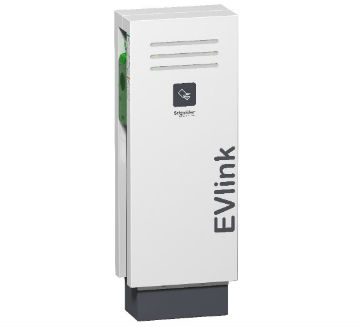EXECUTIVE SUMMARY
-
CVSS v3 9.8
- ATTENTION: Exploitable remotely/low skill level to exploit
- Vendor: Schneider Electric
- Equipment: EVLink Parking
- Vulnerabilities: Use of Hard-coded Credentials, Code Injection, SQL Injection
2. RISK EVALUATION
Successful exploitation of these vulnerabilities could allow an attacker to stop the device and prevent charging, execute arbitrary commands, and access the web interface with full privileges.
3. TECHNICAL DETAILS
3.1 AFFECTED PRODUCTS
The following versions of EVLink Parking, an electric vehicle charging station, are affected:
- EVLink Parking Versions 3.2.0-12_v1 and prior.
3.2 VULNERABILITY OVERVIEW
3.2.1 USE OF HARD-CODED CREDENTIALS CWE-798
A hard-coded credentials vulnerability exists that could enable an attacker to gain access to the device.
CVE-2018-7800 has been assigned to this vulnerability. A CVSS v3 base score of 9.8 has been calculated; the CVSS vector string is (AV:N/AC:L/PR:N/UI:N/S:U/C:H/I:H/A:H).
3.2.2 IMPROPER CONTROL OF GENERATION OF CODE (‘CODE INJECTION’) CWE-94
A code injection vulnerability exists that could allow remote code execution with maximum privileges.
CVE-2018-7801 has been assigned to this vulnerability. A CVSS v3 base score of 8.8 has been calculated; the CVSS vector string is (AV:N/AC:L/PR:N/UI:R/S:U/C:H/I:H/A:H).
3.2.3 IMPROPER NEUTRALIZATION OF SPECIAL ELEMENTS USED IN AN SQL COMMAND (‘SQL INJECTION’) CWE-89
A SQL injection vulnerability exists that could give an attacker access to the web interface with full privileges.
CVE-2018-7802 has been assigned to this vulnerability. A CVSS v3 base score of 6.4 has been calculated; the CVSS vector string is (AV:N/AC:L/PR:L/UI:N/S:C/C:L/I:L/A:N).
3.3 BACKGROUND
- CRITICAL INFRASTRUCTURE SECTORS: Transportation
- COUNTRIES/AREAS DEPLOYED: Worldwide
- COMPANY HEADQUARTERS LOCATION: France
3.4 RESEARCHER
Vladimir Kononovich and Vyacheslav Moskvin of Positive Technologies reported these vulnerabilities to Schneider Electric.
4. MITIGATIONS
Schneider Electric recommends users setup a firewall to restrict remote access to the charging stations by unauthorized users. A software update is also available for download to mitigate these vulnerabilities:
For more information see Schneider Electric’s security notification which can be viewed at the following link:
https://www.schneider-electric.com/en/download/document/SEVD-2018-354-01/
Schneider Electric also recommends the following cybersecurity best practices:
- Locate control and safety system networks and remote devices behind firewalls, and isolate them from the business network.
- Physical controls should be in place so that no unauthorized person would have access to the ICS and safety controllers, peripheral equipment or the ICS and safety networks.
- All controllers should reside in locked cabinets and never be left in the “Program” mode.
- All programming software should be kept in locked cabinets and should never be connected to any network other than the network for the devices that it is intended.
- All methods of mobile data exchange with the isolated network such as CDs, USB drives, etc. should be scanned before use in the terminals or any node connected to these networks.
- Laptops that have connected to any other network besides the intended network should never be allowed to connect to the safety or control networks without proper sanitation.
- Minimize network exposure for all control system devices and/or systems, and ensure that they are not accessible from the Internet.
- When remote access is required, use secure methods, such as virtual private networks (VPNs), recognizing that VPNs may have vulnerabilities and should be updated to the most current version available. Also recognize that VPN is only as secure as the connected devices.
NCCIC reminds organizations to perform proper impact analysis and risk assessment prior to deploying defensive measures.
NCCIC also provides a section for control systems security recommended practices on the ICS-CERT web page. Several recommended practices are available for reading and download, including Improving Industrial Control Systems Cybersecurity with Defense-in-Depth Strategies.
Additional mitigation guidance and recommended practices are publicly available on the ICS-CERT website in the Technical Information Paper, ICS-TIP-12-146-01B–Targeted Cyber Intrusion Detection and Mitigation Strategies.
Organizations observing any suspected malicious activity should follow their established internal procedures and report their findings to NCCIC for tracking and correlation against other incidents.
No known public exploits specifically target these vulnerabilities.
Source:
https://ics-cert.us-cert.gov/advisories/ICSA-19-031-01
